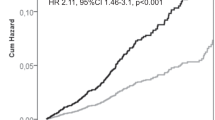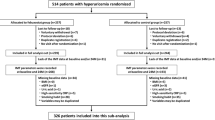Abstract
Carotid intima-media thickness (cIMT) is considered a marker of subclinical atherosclerosis and is related to target-organ damage in hypertensive patients. However, increased cIMT may be due to increases in the thickness of intima (cIT) and media (cMT) layers. This study evaluated whether cIMT layers (cIT and cMT) had a greater association with carotid atherosclerotic plaques and left ventricular hypertrophy (LVH) than cIMT in hypertensive subjects. We cross-sectionally evaluated clinical, carotid, and echocardiography characteristics of 186 hypertensive patients followed at an outpatient clinic. High-resolution images of common carotid arteries were obtained by ultrasonography equipped with 10-MHz transducers, and cIT, cMT, and cIMT were manually measured using an image-processing software. Among all participants (n = 186; age = 60.8 ± 10.9 years, 43% males), there were 58% with carotid plaques and 58% with LVH. Mean cIT, cMT, and cIMT values were 0.267 ± 0.060, 0.475 ± 0.107, and 0.742 ± 0.142 mm, respectively. In logistic regression analysis adjusted for relevant covariates, carotid plaques showed stronger association with cIT than with cMT and cIMT. Furthermore, cIT showed greater area under the ROC curve (0.92; 95% CI 0.87−0.96) than cIMT (0.79; 95% CI 0.72−0.85) and cMT (0.64; 95% CI 0.56−0.72) to identify plaques. Conversely, cIT, cMT, and cIMT had modest association and accuracy to identify LVH (area under the ROC curve = 0.61, 0.57, and 0.60, respectively). In conclusion, cIT is a more accurate marker of atherosclerosis than cMT or cIMT, while cIT and cMT provide no incremental value in identifying LVH when compared with cIMT among hypertensive subjects.
This is a preview of subscription content, access via your institution
Access options
Subscribe to this journal
Receive 12 digital issues and online access to articles
$119.00 per year
only $9.92 per issue
Buy this article
- Purchase on Springer Link
- Instant access to full article PDF
Prices may be subject to local taxes which are calculated during checkout



Similar content being viewed by others
References
van den Oord SC, Sijbrands EJ, ten Kate GL, van Klaveren D, van Domburg RT, van der Steen AF, et al. Carotid intima-media thickness for cardiovascular risk assessment: systematic review and meta-analysis. Atherosclerosis 2013;228:1–11.
Naqvi TZ, Lee MS. Carotid intima-media thickness and plaque in cardiovascular risk assessment. JACC Cardiovasc Imaging 2014;7:1025–38.
Nakashima Y, Fujii H, Sumiyoshi S, Wight TN, Sueishi K. Early human atherosclerosis: accumulation of lipid and proteoglycans in intimal thickenings followed by macrophage infiltration. Arterioscler Thromb Vasc Biol 2007;27:1159–65.
Roman MJ, Saba PS, Pini R, Spitzer M, Pickering TG, Rosen S, et al. Parallel cardiac and vascular adaptation in hypertension. Circulation 1992;86:1909–18.
Martinez-Quinones P, McCarthy CG, Watts SW, Klee NS, Komic A, Calmasini FB, et al. Hypertension induced morphological and physiological changes in cells of the arterial wall. Am J Hypertens 2018;31:1067–78.
Zanchetti A, Hennig M, Hollweck R, Bond G, Tang R, Cuspidi C, et al. Baseline values but not treatment-induced changes in carotid intima-media thickness predict incident cardiovascular events in treated hypertensive patients: findings in the European Lacidipine Study on Atherosclerosis (ELSA). Circulation 2009;120:1084–90.
Kawai T, Ohishi M, Takeya Y, Onishi M, Ito N, Oguro R, et al. Carotid plaque score and intima media thickness as predictors of stroke and mortality in hypertensive patients. Hypertens Res 2013;36:902–9.
Cuspidi C, Sala C, Tadic M, Gherbesi E, Grassi G, Mancia G. Pre-hypertension and subclinical carotid damage: a meta-analysis. J Hum Hypertens 2019;33:34–40.
Sardeli AV, Gáspari AF, de Rossi G, de Souza GV, de Souza TMF, Cavaglieri CR, et al. Carotid intima-media thickness is associated with media rather than intima thickness. Atherosclerosis 2017;261:169–71.
Rodriguez-Macias KA, Lind L, Naessen T. Thicker carotid intima layer and thinner media layer in subjects with cardiovascular diseases. An investigation using noninvasive high-frequency ultrasound. Atherosclerosis 2006;189:393–400.
Xu M, Jin S, Li F, Jia G, Zhang C, Zhang M, et al. The diagnostic value of radial and carotid intima thickness measured by high-resolution ultrasound for ischemic stroke. J Am Soc Echocardiogr 2021;34:72–82.
Carvalho-Romano LFRS, Bonafé RP, Paim LR, Marques ER, Vegian CFL, Pio-Magalhães JA, et al. Association of left ventricular strain and E/e’ ratio with carotid wall layers. Atherosclerosis. 2020;310:109–10.
Nadruz W. Myocardial remodeling in hypertension. J Hum Hypertens 2015;29:1–6.
Magnussen CG. Carotid artery intima-media thickness and hypertensive heart disease: a short review. Clin Hypertens 2017;23:7.
Insull W Jr. The pathology of atherosclerosis: plaque development and plaque responses to medical treatment. Am J Med 2009;122:S3–S14.
Polak JF, Szklo M, Kronmal RA, Burke GL, Shea S, Zavodni AE, et al. The value of carotid artery plaque and intima-media thickness for incident cardiovascular disease: the multi-ethnic study of atherosclerosis. J Am Heart Assoc 2013;2:e000087.
Simova I. Intima-media thickness: appropriate evaluation and proper measurement. E-J Cardiol Pract. 2015;13:1.
Ferreira-Sae MC, Cipolli JA, Cornélio ME, Matos-Souza JR, Fernandes MN, Schreiber R, et al. Sodium intake is associated with carotid artery structure alterations and plasma matrix metalloproteinase-9 upregulation in hypertensive adults. J Nutr 2011;141:877–82.
Marques ER, Gemignani T, Azevedo RC, Higa CM, Coelho-Filho OR, Matos-Souza JR, et al. Distinct factors are related to lower limb atherosclerosis in smokers and nonsmokers. J Hypertens 2018;36:2390–7.
Lacchini R, Jacob-Ferreira AL, Luizon MR, Coeli FB, Izidoro-Toledo TC, Gasparini S, et al. Matrix metalloproteinase 9 gene haplotypes affect left ventricular hypertrophy in hypertensive patients. Clin Chim Acta 2010;411:1940–4.
Lacchini R, Jacob-Ferreira AL, Luizon MR, Gasparini S, Ferreira-Sae MC, Schreiber R, et al. Common matrix metalloproteinase 2 gene haplotypes may modulate left ventricular remodelling in hypertensive patients. J Hum Hypertens 2012;26:171–7.
DE Rossi G, Matos-Souza JR, Costa E Silva AD, Campos LF, Santos LG, Azevedo ER, et al. Physical activity and improved diastolic function in spinal cord-injured subjects. Med Sci Sports Exerc 2014;46:887–92.
Lang RM, Bierig M, Devereux RB, Flachskampf FA, Foster E, Pellikka PA. et al. Recommendations for chamber quantification. Eur J Echocardiogr. 2006;7:79–108.
Mach F, Baigent C, Catapano AL, Koskinas KC, Casula M, Badimon L, et al. ESC/EAS guidelines for the management of dyslipidaemias: lipid modification to reduce cardiovascular risk. Eur Heart J 2020;41:111–88. 2019
Akhter T, Wikström AK, Larsson M, Naessen T. Individual common carotid artery wall layer dimensions, but not carotid intima-media thickness, indicate increased cardiovascular risk in women with preeclampsia: an investigation using noninvasive high-frequency ultrasound. Circ Cardiovasc Imaging 2013;6:762–8.
Lee MY, Wu CM, Yu KH, Chu CS, Lee KT, Sheu SH, et al. Association between hemodynamics in the common carotid artery and severity of carotid atherosclerosis in patients with essential hypertension. Am J Hypertens 2008;21:765–70.
Prado CM, Rossi MA. Circumferential wall tension due to hypertension plays a pivotal role in aorta remodelling. Int J Exp Pathol 2006;87:425–36.
Nadruz W Jr, Lagosta VJ, Moreno H Jr, Coelho OR, Franchini KG. Simvastatin prevents load-induced protein tyrosine nitration in overloaded hearts. Hypertension 2004;43:1060–6.
Zmysłowski A, Szterk A. Current knowledge on the mechanism of atherosclerosis and pro-atherosclerotic properties of oxysterols. Lipids Health Dis 2017;16:188.
Kaunas R, Usami S, Chien S. Regulation of stretch-induced JNK activation by stress fiber orientation. Cell Signal 2006;18:1924–31.
Nadruz W Jr, Kobarg CB, Kobarg J, Franchini KG. c-Jun is regulated by combination of enhanced expression and phosphorylation in acute-overloaded rat heart. Am J Physiol Heart Circ Physiol 2004;286:H760–H767.
Polak JF, Johnson C, Harrington A, Wong Q, O’Leary DH, Burke G, et al. Changes in carotid intima-media thickness during the cardiac cycle: the multi-ethnic study of atherosclerosis. J Am Heart Assoc 2012;1:e001420.
Funding
The study was supported by the Brazilian National Council for Scientific and Technological Development (CNPq; grant 306154/2017-0) and São Paulo Research Foundation (FAPESP 2013/07607-8) for Dr. Nadruz.
Author information
Authors and Affiliations
Corresponding author
Ethics declarations
Competing interests
The authors declare no competing interests.
Additional information
Publisher’s note Springer Nature remains neutral with regard to jurisdictional claims in published maps and institutional affiliations.
Supplementary information
Rights and permissions
About this article
Cite this article
Carvalho-Romano, L.F., Bonafé, R.P., Paim, L.R. et al. Association of carotid wall layers with atherosclerotic plaques and cardiac hypertrophy in hypertensive subjects. J Hum Hypertens 36, 732–737 (2022). https://doi.org/10.1038/s41371-021-00565-w
Received:
Accepted:
Published:
Issue Date:
DOI: https://doi.org/10.1038/s41371-021-00565-w



